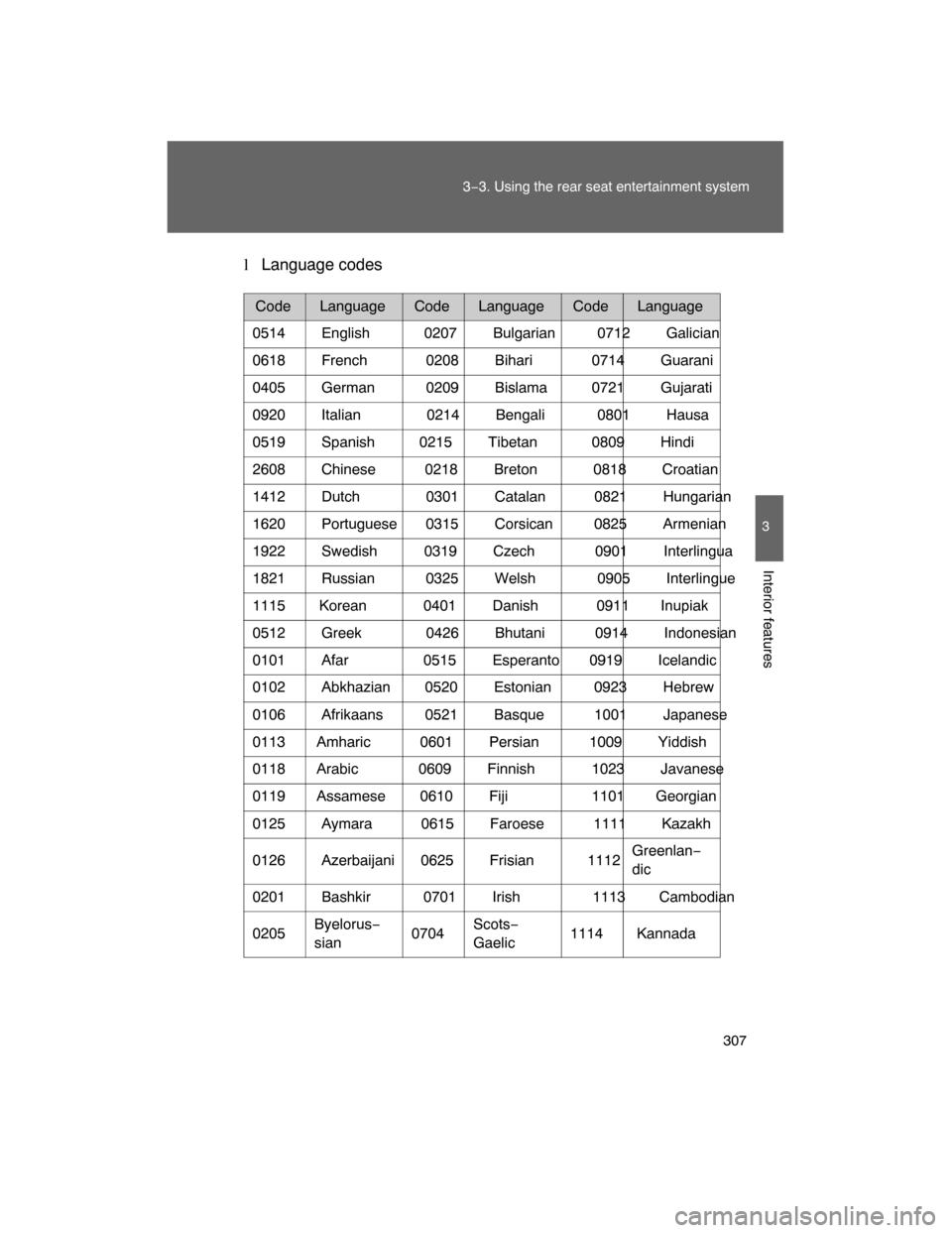Page 303 of 531

307
3−3. Using the rear seat entertainment system
3
Interior features
lLanguage codes
CodeLanguageCodeLanguageCode Language
0514 English 0207 Bulgarian 0712 Galician
0618 French 0208 Bihari 0714 Guarani
0405 German 0209 Bislama 0721 Gujarati
0920 Italian 0214 Bengali 0801 Hausa
0519 Spanish 0215 Tibetan 0809 Hindi
2608 Chinese 0218 Breton 0818 Croatian
1412 Dutch 0301 Catalan 0821 Hungarian
1620 Portuguese 0315 Corsican 0825 Armenian
1922 Swedish 0319 Czech 0901 Interlingua
1821 Russian 0325 Welsh 0905 Interlingue
1115 Korean 0401 Danish 0911 Inupiak
0512 Greek 0426 Bhutani 0914 Indonesian
0101 Afar 0515 Esperanto 0919 Icelandic
0102 Abkhazian 0520 Estonian 0923 Hebrew
0106 Afrikaans 0521 Basque 1001 Japanese
0113 Amharic 0601 Persian 1009 Yiddish
0118 Arabic 0609 Finnish 1023 Javanese
0119 Assamese 0610 Fiji 1101 Georgian
0125 Aymara 0615 Faroese 1111 Kazakh
0126 Azerbaijani 0625 Frisian 1112Greenlan−
dic
0201 Bashkir 0701 Irish 1113 Cambodian
0205Byelorus−
sian0704Scots−
Gaelic
1114 Kannada
Page 354 of 531

358 3−6. Other interior features
nBefore programming
lInstall a new battery in the remote control transmitter.
lThe battery side of the remote control transmitter must be pointed away
from the HomeLink button.
nCertification for the garage door opener
This device complies with Part 15 of the FCC Rules and with RSS−210 of the
IC Rules.
Operation is subject to the following two conditions: (1) this device may not
cause harmful interference, and (2) this device must accept any interference
received, including interference that may cause undesired operation.
WARNING: This transmitter has been tested and complies with FCC and IC
rules. Changes or modifications not expressly approved by the party respon−
sible for compliance could void the user ’s authority to operate the device.
CAUTION
nWhen programming a garage door or other remote control devices
The garage door or other devices may operate, so ensure people and
objects are out of danger to prevent potential harm.
nConforming to federal safety standards
Do not use the HomeLink
compatible transceiver with any garage door
opener or device that lacks safety stop and reverse features as required by
federal safety standards.
This includes any garage door that cannot detect an interfering object. A
door or device without these features increases the risk of death or serious
injury.
Page 359 of 531

364 4−1. Maintenance and care
NOTICE
nCleaning detergents
Do not use the following types of detergent, as they may discolor the vehicle
interior or cause streaks or damage to painted surfaces.
lNon−seat portions: Organic substances such as benzene or gasoline,
alkaline or acidic solutions, dye, or bleach.
lSeats: Acidic solutions, such as thinner, benzene, or alcohol.
nPreventing damage to leather surfaces
Observe the following precautions to avoid damage to and deterioration of
leather surfaces.
lRemove any dust or dirt on leather surfaces immediately.
lDo not expose the vehicle to direct sunlight for extended periods of time.
Park the vehicle in the shade, especially during summer.
lDo not place items made of vinyl, plastic, or that contain wax on the uphol−
stery, as they may stick to the leather surface if the vehicle interior heats
up significantly.
nWater on the floor
Do not wash the vehicle floor with water.
Vehicle systems such as the audio system may be damaged if water comes
into contact with electrical components under the floor of the vehicle, and
may also cause the body to rust.
n
Cleaning the inside of the rear window
Be careful not to scratch or damage the heater wires or antenna.
Page 393 of 531

398 4−3. Do−it−yourself maintenance
nTire pressure warning system certification
This device complies with Part 15 of
the FCC Rules. Operation is subject
to the following two conditions: (1) this device may not cause harmful
interference, and (2) this device must
accept any interference received,
including interference that may cause undesired operation.
NOTICE:
This equipment has been tested and found to comply with the limits for a
Class B digital device, pursuant to Pa
rt 15 of the FCC Rules. These lim−
its are designed to provide reasonable protection against harmful inter−
ference in a residentialinstallation. This equipment generates, uses and
can radiate radio frequency energy and, if not installed and used in
accordance with the instructions, may cause harmful interference to
radio communications. However, there is no guarantee that interference
will not occur in a particul
ar installation. If this equipment does cause
harmful interference to radio or tele vision reception, which can be deter−
mined by turning the equipment off and on, the user is encouraged to try
to correct the interference by one or more of the following measures:
lReorient or relocate the receiving antenna.
lIncrease the separation between the equipment and receiver.
lConnect the equipment into an outlet on a circuit different from that to
which the receiver is connected.
lConsult the dealer or an experienced radio/TV technician for help.
FCC WARNING:
Changes or modifications not expre ssly approved by the party responsi−
ble for compliance could void the user ’s authority to operate the equip−
ment.
Page 452 of 531

458 5−2. Steps to take in an emergency
CAUTION
n Maintenance of the tires
Each tire, including the spare (if provided), should be checked monthly
when cold and inflated to the inflation pressure recommended by the
vehicle manufacturer on the vehicle
placard or tire inflation pressure
label (tire and load information label). (If your vehicle has tires of a differ−
ent size than the size indicated on the vehicle placard or tire inflation
pressure label [tire and load information label], you should determine the
proper tire inflation pr
essure for those tires.)
As an added safety feature, your
vehicle has been equipped with a tire
pressure monitoring system (TPMS−ti re pressure warning system) that
illuminates a low tire pressure telltal e (tire pressure warning light) when
one or more of your tires is significantly under−inflated. Accordingly,
when the low tire pressu
re telltale (tire pressure warning light) illumi−
nates, you should stop and check your tires as soon as possible, and
inflate them to the proper pressure. Driving on a significantly under−
inflated tire causes the tire to overheat and can lead to tire failure.
Under−inflation also reduces fuel effi
ciency and tire tread life, and may
affect the vehicle’s handling and stopping ability.
Please note that the TPMS (tire pressure warning system) is not a sub−
stitute for proper tire main tenance, and it is the driver ’s responsibility to
maintain correct tire pressure, even if under−inflation has not reached the
level to trigger illu
mination of the TPMS low ti re pressure telltale (tire
pressure warning light).
Page 504 of 531

511
6−1. Specifications
6
Vehicle specifications
nTreadwear
The treadwear grade is a comparative rating based on the wear
rate of the tire when tested under controlled conditions on a speci−
fied government test course.
For example, a tire graded 150 would wear one and a half (1 − 1/2)
times as well on the government course as a tire graded 100.
The relative performance of tires
depends upon the actual conditions
of their use, however, and may depart significantly from the norm due
to variations in driving habits, service practices and differences in
road characteristics and climate.
nTraction AA, A, B, C
The traction grades, from highest to lowest, are AA, A, B and C,
and they represent the tire’s ab ility to stop on wet pavement as
measured under controlled cond itions on specified government
test surfaces of asphalt and concrete.
A tire marked C may have poor traction performance.
Warning: The traction grade assigned to this tire is based on braking
(straight ahead) traction tests and does not include cornering (turn−
ing) traction.
nTemperature A, B, C
The temperature grades are A (the highest), B, and C, represent−
ing the tire’s resistance to the generation of heat and its ability to
dissipate heat when tested under controlled conditions on a speci−
fied indoor laboratory test wheel.
Sustained high temperature can cause the material of the tire to
degenerate and reduce tire life, and excessive temperature can lead
to sudden tire failure.
The grade C corresponds to a level of performance which all passen−
ger car tires must meet under the Federal Motor Vehicle Safety Stan−
dard No. 109.
Grades B and A represent higher levels of performance on the labo−
ratory test wheel than the minimum required by law.
Page 529 of 531
538
What to do if...
What to do if...
A tire puncturesP. 463If you have a flat tire
The engine does not start
P. 9 3Engine immobilizer system
P. 476If the engine will not start
P. 484If the battery is discharged
The shift lever cannot be
moved outP. 478If the shift lever cannot be shifted
The engine coolant temperature
gauge enters the red zone
Steam can be seen coming
from under the hood
P. 488If your vehicle overheats
The key is lostP. 479If you lose your keys
The battery runs outP. 484If the battery is discharged
The doors cannot be lockedP. 4 3Side doors
P. 4 8Back doors
The horn begins to soundP. 9 7Alarm
The vehicle is stuck in mud
or sandP. 491If the vehicle becomes stuck
The warning light or indi−
cator light comes onP. 449If the warning light turns on